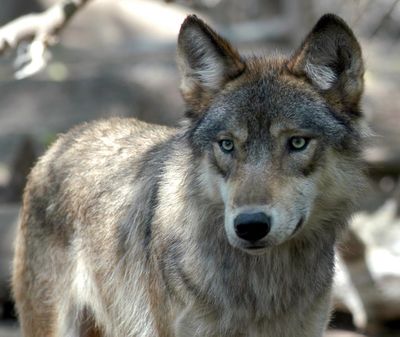Fish and Wildlife unveils wolf plan
It includes long-term goal of 15 breeding pairs

International borders and state lines are no deterrent to gray wolves, which are drifting into Washington from neighboring packs in British Columbia, Idaho and Montana.
At least two wolf packs have produced pups in the state, and wildlife officials say they wouldn’t be surprised if a third pack with pups is confirmed by next summer.
On Tuesday, the state Department of Fish and Wildlife released a plan for managing wolves in Washington. Developed over two years with suggestions from a 17-member citizens group, it tries to strike a balance between allowing wolves to occupy their ecological role as top predators and reducing conflicts with people’s pets and livestock.
“We’re trying to satisfy the idea of letting a native predator return to the native ecosystem … and once again become part of Washington’s wildlife,” said Madonna Luers, a Fish and Wildlife department spokeswoman.
But there are limitations to that concept in a state with more than 6 million people, she added. “We’re not going to live side-by-side with a historic population of wolves.”
Part of the debate revolves around the question of how many wolves are enough. The management plan lists a long-term goal of 15 breeding pairs in Washington, distributed throughout the state. Wolf experts from around the country reviewed the goal. Some thought 15 breeding pairs was more than enough for a self-perpetuating wolf population, while others thought the number was too low, Luers said.
She’s expecting roughly the same reaction at 12 public meetings scheduled across the state. People can submit comments on the plan through Jan. 8. The Washington Fish and Wildlife Commission will decide whether to adopt the plan next year. Managing wolves in the state is expected to cost between $326,000 and $665,000 annually during the first three years, including salaries for two wolf specialists.
Gray wolves, once common throughout most of the state, declined rapidly as farms and ranches multiplied on the landscape. By the 1930s, they were virtually extinct in Washington.
Wolf sightings started resurfacing in the North Cascades during the early 1990s. Since then, reports of sightings and howling have trickled in from the Blue Mountains of southeast Washington, the Okanogan Highlands and rural areas of northeast Washington.
Last year, a pack with pups was discovered in western Okanogan County. In July, a second pack with pups was confirmed in Pend Oreille County.
Wolf populations aren’t expected to rebound as quickly here as they did in Yellowstone National Park and central Idaho, because Washington doesn’t have large tracts of protected habitat. Some experts think it could take decades to produce more than a few breeding pairs.
While wildlife officials don’t plan to transplant new wolves into Washington, they could move the state’s wolves around, Luers said. Mount St. Helens, for instance, has more elk than suitable habitat. A resident wolf pack to cull the herd could be a benefit, she said.
Most Washington residents support a wolf population in the state, according to a 2008 poll, which put support levels at 75 percent. But a majority – 61 percent – also supported killing wolves that attack livestock.
Building human tolerance for wolves is a vital aspect of their long-term recovery, the plan said. Washington’s management plan allows for the West’s most generous reimbursement rates to ranchers for wolf kill.
“If we move forward with the plan, we’d be paying twice the value of a cow lost to wolves,” Luers said.
Wolves lost their federal protection in the eastern third of Washington last spring, when the U.S. Fish and Wildlife Service took wolves in the Northern Rockies off of the Endangered Species List. That decision, which excluded Wyoming’s wolf population, led to public wolf hunts in Idaho and Montana. It’s being challenged in court.
Wolves remain federally protected in the western two-thirds of Washington. They are also on the state’s endangered species list, which precludes hunting at this time.
“Wolves are coming, and we need to be prepared for them,” Luers said. “Not only so that we can conserve them, but so that we’re prepared for the conflicts that come with them.”